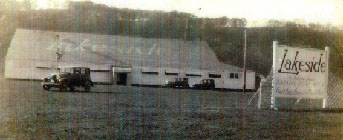|
Lakeside was built by William (Hubert) Kann in 1927 on a vacant lot on the north end of Guttenberg for an original cost
of $27,000. It was to be a place for his children and the local citizens to congregate, play music, and have fun.
Bill and his wife Josephine were exceedingly interested in music. Their living room was actually a music room with
large oak cases containing just about every musical instrument available at the time. There were violins, a clarinet, saxophone,
flute, mandolin, and guitars. A large piano dominated the room. If business was slow in his General Merchandise store, after
dinner Bill would relax in the living room playing the violin while his wife accompanied him on the brass. The children could
select whatever they wanted to play along. Many evenings were spent entertaining each other with music. Bill hired a music
teacher from Dubuque to come once a week and give classes to their children. Miss Schaetsley arrived on the local train from
Dubuque on Friday night, had dinner with the family, taught the children all day the next day and returned to Dubuque again
by train that evening. Daughter, May, remembers her first piano recital at three years old. Her feet didn't reach the floor
to use the piano pedals but she performed for an array of guests.
As the children entered their teen years Bill had a family of very talented musicians and was concerned with his childrens
activities as any parent today. He combined his concern with his business knowledge and decided a ballroom would be a good
venture. He turned to his friend, Louis Bahls, to discuss the mechanics of a good dance floor. Though uneducated as a tradesman,
Louis was a genius with the blending of woods, how to make them fit and grow together. Many long evenings were spent in discussion
of a good floor while the two gentlemen leaned back in their arm chairs and braced their feet against the pot belly stove
in the back of Bill's store. A dance floor should be something so comfortable that people wouldn't get tired. It should give
spring to their movements. With that thought, the 1 1/ 4" hardwood floor was constructed using fir. To enhance the sound
effect of this building they imagined a ceiling with hundreds of little lights flickering on a blue background. Lattice work
over this would soften those tones. Bill hired Louis Schroeder, a local carpenter, to do the actual building. Today the original
floor and ceiling are still utilized in the ballroom.
The first dance (August 18, 1927) at Lakeside drew a crowd of nearly 1,800 participants coming to see Little Benny's Orchestra
from Minneapolis. By early October it is estimated that nearly 10,000 people had danced on Lakeside's hardwood maple floor.
There was no lock and dam in Guttenberg at the time so the ballroom market area included Glen Haven and Cassville Wisconsin.
Bill purchased a river launch to motor to the towns in Wisconsin, pick up guests and deliver them to the Guttenberg side of
the river behind his warehouse. There they were met with a Studebaker limousine to carry them to Lakeside on the north side
of Guttenberg. All this travel was free or included in the price of a night's ticket.
Lakeside was a family affair. It wasn't long before the evening of music was preceded by afternoon ballgames. Guests could
picnic in the yard, participate in an afternoon ballgame and enjoy an evening of music and dance. The extravagant floor that
the two gentlemen had spent so many nights discussing was a tremendous success. People loved to dance and never seemed to
get tired.
They painted the name Lakeside in large letters on the roof of the building to use for aerial dead-recognizing navigation,
the only method of navigation at the time. Lindberg and other pioneer aviators used Lakeside as a checkpoint flying from Minneapolis
to Chicago and St. Louis.
The big bands kept the sound of music filling the Lakeside until the '60s when rock and roll music impacted Iowa's entertainment
scene. The ballroom with its wonderful dance floor and sterling reputation, provided a perfect venue for the music that would
rock the nation for generations to come.
In 2006 Lakeside was purchased by Lakeside Preservation Committee LLC.
Lakeside Ballroom will be celebrating its 80th Anniversary on August 18th, 2007
Bands who have entertained at Lakeside Ballroom:
Late 20's thru the 30's
Little Benny & his Ten Tiny Tots, Coon Sanders Original Nighthawks, Ted Weems Orchestra, Zez Confrey Orchestra, and
the 10 member "colored" orchestra, Jesse Stone and his Blue Serenaders, who played their hists "Baby Girl"
and "Waiting For The Moon".
The 40's and 50's
Jan Garber Orchestra, Art Kassel Orchestra, Rex Morgan Orchestra, Leo Greco and his Pioneers, Tom Owens Cowboys, Johnny
Kettleson, Johnny Cash, Brenda Lee, Andy Doll, Tommy Overstreet, Guy Lombardo, and Lawrence Welk
The 60's and 70's
Everly Brothers, Herman's Hermits, The Echoes, Hank Thompson, Mickey Gilley, The Grassroots, Vixen, Bullet, Tommy James
and the Shondells, Head East, and Tommy Overstreet.
Throughout the timespan of Lakeside Ballroom, local bands made it big here. Some of those include: Gary Willie and his
Countrymen, Frank Barry and his Music Masters, Southern Comfort, Sounds of Nashville, Dealer's Choice, and Tussle.
|



